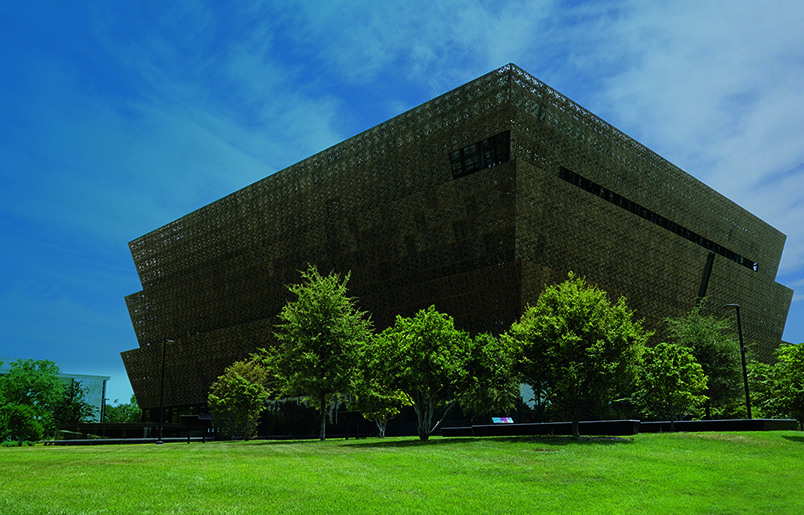Mandate for Justice: Inside and Outside
“What Will We Do Now?”

Domestic Travel Seminars Inform and Transform
By Rev. Rodney Sadler, Ph.D.
During the course of the 2021-22 academic year, Union Presbyterian Seminary sponsored two domestic travel seminars. These were the first such trips taken by the institution since the beginning of the pandemic and provided the first opportunity for our Seminary to offer domestic travel seminars for our students. The trips were originally envisioned as one larger experience, but time and cost considerations intervened and we choose instead to offer them as separate, though related justice-oriented intensive learning trips.
The first of these was originally planned for the break between the fall and spring semesters, but was postponed in large part due to the increase in COVID-19 infections in the regions we were planning to visit. When it was rescheduled for the spring reading days, fewer students were able to attend, but we still were able to offer the opportunity to about 40 people.
The first travel seminar (actually, the first leg of this two-part process) embarked from the Charlotte campus on a large tour bus, and we began our trek in Selma, Alabama. Our first stop was at the base of the Edmund Pettus Bridge, where we met Miss Annie Pearl and Miss X, both of whom were witnesses to the Bloody Sunday march on March 7, 1965. Miss Pearl had been an organizer with the SNCC and the SCLC, and told tales not only about that day, but also about organizing the subsequent successful Selma to Montgomery march that began two weeks later on March 21.
Miss X shared a powerful narrative of being at the Bloody Sunday march and being separated from her sister, only to find her later, covered in blood after having been beaten by the Alabama State Police. The heavens opened as we stood there listening to these two women, and it was clear that the faces of our participants were moistened not only by rain, but also by tears as they reflected on the history that took place at this location.
After leaving the base, we proceeded to cross the Edmund Pettus Bridge (odd that a significant Civil Rights site bears the name of a confederate general and Grand Dragon of the Alabama Ku Klux Klan) arm in arm, singing “We Shall Overcome.” Arriving at the other side of the bridge, we were able to reflect on our experience there and begin our week of pilgrimage with a celebration of a liberation Eucharist.
From Selma, we traveled to Montgomery, where the next day began on the banks of the Alabama River, at the port where enslaved people were brought from ports to the north to replenish the plantations in this harsh Deep South region. The need for a constant resupply of enslaved humanity was high because the brutality of these conditions reduced the life expectancy of Africans who were frequently worked to death. After learning about life of these kidnapped peoples by the docks, we walked arm in arm, replicating a late night march of humans made chattel to the warehouses, where they were kept until they were auctioned off to the highest bidder.
Our march ended near these warehouses, and we began our tour of Bryan Stevenson’s and the Equal Justice Initiative’s newly reopened and expanded Legacy Museum. Hardly a more moving museum could be imagined, as the exhibits recounted with great pathos the story of slavery in America—from the theft of people from Africa, to their enslavement, to their experiences of limited “freedom” and the struggle for Civil Rights, to the present crisis of Mass Incarceration. If you have never comprehended the interconnectivity of this progression before, the museum does a fine job of ensuring that you will after your encounter with living ghosts of a not-so-distant past.
From the Legacy Museum, we traveled a few blocks to the National Memorial for Peace and Justice, also conceived by the Equal Justice Initiative, which records the history of lynchings in the American South, and the terror and trauma they engendered in the Black community. In one sobering exhibit, the reality of the experience was brought home for visitors who could see how many documented lynchings occurred in their own home states and counties.
From Montgomery, we backtracked to Atlanta, to spend time at The King Center and at the National Center for Civil and Human Rights. Our time at The King Center was brief, but punctuated by the potency of the tombs of Martin and Coretta, the garden and fountain, and Ebenezer Baptist Church, which stood just a block away. Our pilgrims were inspired by the manifold quotations from Martin and Coretta that were inscribed along the garden walls. We found the Center for Civil and Human Rights to be a significant stop that both gave us both the opportunity to read some of King’s original writings and to see how the Civil Rights Movement was connected to and inspirational for human rights movements across the globe.
The next several days included stops in Birmingham, Alabama, at the Civil Rights Museum outside of 16th Street Baptist Church, where four little girls were murdered in a Klan bombing in 1963; in Little Rock, Arkansas, where, after worshipping at Second Presbyterian Church, we spent time at Central High School, where the Little Rock Nine integrated the student body in 1957; in Jackson, Mississippi, at Medgar Evers’s home (where many tears were shed as we stood in a circle on his lawn and prayed for better days); and at the Mississippi Civil Rights Museum, which is one of the newest museums working to record the Civil Rights story, with an emphasis on Mississippi history. Here, not only did we hear testimony from one of the local men arrested during Freedom Summer, but we also met Dean Boyce’s “Uncle Charlie X,” his mother’s brother, who was an older arrestee during Freedom Summer, through pictures on the exhibit wall. Uncle Charlie really brought home the story for so many of us, as a white Presbyterian professor so moved by the movement that he sought a means to contribute and work for change. He serves as a reminder for us all of the necessity to get involved in the work for justice.
Our last few days, spent in Tennessee, were among the most moving for us. In Memphis, we spent time at the National Civil Rights Museum at the Lorraine Motel and heard the story of Dr. King’s last days. Hearts were in throats when, at the end of a walk through Civil Rights history, pilgrims found themselves in Dr. King’s motel room, looking out onto the balcony where he was slain on the evening of April 4, 1968.
We spent the last two days of our sojourn in Nashville, where we were blessed to have an encounter with formerly incarcerated persons, as well as residents of Riverbend Maximum Security Institution on death row and with men sentenced to life in prison. Contrary to what we might have expected, we found great grace and generosity of spirit there as Rev. Dr. Janet Wolf introduced us to the men with whom she ministers. These men have formed worshipping communities among themselves to create a church experience that was no less authentic than what we had experienced at Little Rock Second Presbyterian. The trip ended bringing us full circle to one of the modern day movements for Civil Rights, as we confronted the terror of African American Mass Incarceration and learned that there is a role for us to play in this continued struggle.
In nine days, we visited eight cities and returned transformed souls. The history of struggle for African American equality became clearer, as did the understanding of the necessity for us as Christians to become actively involved in the struggle. Having seen the stories of disenfranchised Africans—from capture and kidnapping, to forced transport, to enslavement, to “freedom,” to lynching, to Civil Rights, to the War on Drugs and Mass Incarceration, the haunting introspective question raised by Bryan Stevenson took on a renewed relevance: “What would you have done if you were there then?”
It was evident after our travels that the “there” and “then” of racial oppression are also the “here” and “now,” and that we all have work to do if we are ever to achieve a more just America. So that revised question lingers for each of us as pilgrims: ”What will we do now?”
Rodney S. Sadler Jr. is an ordained Baptist minister and is Associate Professor of Bible and Director of the Center for Social Justice and Reconciliation at Union Presbyterian Seminary. His teaching experience includes courses in biblical languages, Old and New Testament interpretation, wisdom literature in the Bible, the history and religion of ancient Israel, and African American biblical interpretation. His first authored book, Can A Cushite Change His Skin? An Examination of Race, Ethnicity, and Othering in the Hebrew Bible, was published in 2005. He frequently lectures within the church and the community on Race in the Bible, African American Biblical Interpretation, the Image of Jesus, Biblical Archaeology, and the Dead Sea Scrolls. He is the managing editor of the African-American Devotional Bible.








